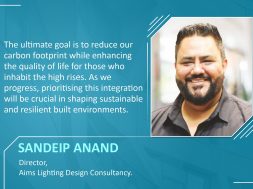Lighting designs balance aesthetics, functionality, and sustainability

This interaction delves into the creative process for designing high-rise lighting, ensuring a fine balance between aesthetics, functionality, and sustainability.
As the norm goes, a lighting design must be customised to each space and its purpose. What is your creative process when designing lighting for high-rise buildings?
As a lighting consultant, I craft schemes for high-rise buildings, balancing aesthetics, functionality, and sustainability. The key considerations that I take into account are architecture, purpose, and surroundings; layered lighting approach (ambient, task, accent, decorative); façade materials and emphasis (vertical/horizontal); and energy efficiency (LEDs, smart controls, daylight harvesting). I initially do a site analysis, define the lighting concept and purpose, and then create the lighting design considering sustainability and energy efficiency.
What are the specific technical requirements while lighting up high rises? Do they differ for residential, commercial, and industrial projects?
The technical requirements for lighting up the facades of high-rise buildings are multifaceted and vary depending on the project’s nature. A thorough understanding of these elements ensures compliance with regulations and achieves an aesthetic and functional lighting solution that enhances the building’s presence in its environment. Whether for residential, commercial, or industrial applications, the principles of good design are “to illuminate, to beautify, and to integrate seamlessly with the architecture and all its elements”.
What strategies do you adopt to integrate natural light with artificial lighting to generate more sustainable designs?
As a lighting consultant, my approach to integrating natural light with artificial lighting is rooted in sustainability. In large-scale projects, this synergy enhances aesthetic appeal and significantly reduces energy consumption. The key strategies we employ to achieve this balance include daylight harvesting, smart lighting controls, dynamic lighting design, layered lighting approach, tunable white light, glazing options, and educating occupants about the benefits of natural light.
What are the challenges associated with designing lighting for high rises? What are your thoughts on dealing with these challenges?
The sheer height of high-rise buildings can create significant difficulties in achieving uniform lighting, and maintaining lighting fixtures at these heights can be challenging and costly. I advocate for using flexible lighting solutions that can adapt to the building’s unique contours and textures, which can be designed by collaborating closely with architects and designers. Similarly, mock-ups and simulations during the design phase can help visualise how different lighting methods interact with the architecture. High-rise buildings can contribute to light pollution and create glare issues for occupants and surrounding areas. Using shielded fixtures and appropriate lighting angles can minimise glare and direct light where needed. Incorporating energy-efficient lighting takes care of energy efficiency and sustainability. We can overcome these challenges through collaboration and forward-thinking design and set new standards for sustainable, functional, and aesthetically pleasing high-rise lighting.
How have LEDs contributed to the lighting of high rises?
The key advantages include energy efficiency, longevity and maintenance, and colour and tenability. LEDs offer various colour temperatures and can be tuned for specific applications. This feature allows designers to create varied atmospheres within different spaces of a high-rise building. LEDs will remain at the forefront of innovation as we continue to push the boundaries of architectural lighting, enabling us to create sustainable, aesthetically pleasing, and functional environments in high-rise buildings.
What is your philosophy for making high-rise light designs more energy efficient?
As a lighting consultant focused on energy efficiency for high-rise buildings, my philosophy centres around a holistic approach that integrates aesthetics, functionality, and sustainability. I start with a comprehensive assessment, followed by efficient technology and smart lighting controls. I incorporate adaptive lighting systems, responsive controls, and programmable settings to optimise energy use and enhance user experience. I collaborate closely with architects and HVAC specialists to ensure the lighting design works harmoniously with other building systems, contributing to overall energy efficiency.
For more details, visit: https://aimsolutions.co.in/index1.html#!/page_SPLASH
Cookie Consent
We use cookies to personalize your experience. By continuing to visit this website you agree to our Terms & Conditions, Privacy Policy and Cookie Policy.










